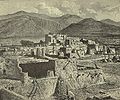Taos Pueblo
Taos Pueblo | |
| File:NMtrip-05-042.jpg Taos Pueblo today | |
| Nearest city | Taos, New Mexico |
|---|---|
| NRHP reference No. | 66000496 [1] |
| Added to NRHP | October 15, 1966 |
| UNESCO World Heritage Site | |
|---|---|
| Criteria | Cultural: iv |
| Reference | 492 |
| Inscription | 1992 (16th Session) |
Taos Pueblo (or Pueblo de Taos), continuously inhabited for more than 1,000 years, is the ancient pueblo of a Northern Tiwa speaking Native American tribe of Pueblo people. It lies about 1 mile (1.6 km) north of the modern city of Taos, New Mexico, USA, on Red Willow Creek or Rio Pueblo, a small stream which flows from the Sangre de Cristo Range. 95,000 acres (384 km²) are attached to the pueblo, and about 2,000 people live there. In the Northern Tiwa language, the name of Taos is Tua-tah, which means "our village." Taos Pueblo is a member of the Eight Northern Pueblos.
Taos Pueblo's most prominent architectural feature is a multi-storied residential complex of reddish-brown adobe divided into two parts by the Rio Pueblo. According to the Pueblo's Web site, it was probably built between 1000 and 1450 A.D. It was designated a National Historic Landmark on October 9, 1960, and later became a World Heritage Site. As of 2006, about 150 people live in it full-time.
History
The history of Taos Pueblo include the plotting of the Pueblo Revolt in 1680, a siege by U.S. forces in 1847, and the return by President Nixon in 1970 of the Pueblo's 48,000 acres (194 km²) of mountain land taken by President Theodore Roosevelt and designated as the Carson National Forest early in the twentieth century. Blue Lake, which the people of the Pueblo traditionally consider sacred, was included in this return of Taos land. The Pueblo's web site names the acquisition of the sacred Blue Lake as the most important event in its history due to the spiritual belief that the Taos natives originated from the lake itself.
Most archeologists believe that the Taos Indians along with other casino Indians settled along the Rio Grande migrated from the Four Corners region. The dwellings of that region were inhabited by the Anasazi, and a long drought in the area in the late 1200s, may have caused them to move to the Rio Grande where the water supply was more dependable.
Structure
The North-Side Pueblo is said to be one of the most photographed and painted buildings in the Western Hemisphere. It is the largest multistoried Pueblo structure still existent and continuously endangered. It is made of adobe walls that are often several feet thick. Its primary purpose was for defense. Up to as late as 1900, access to the rooms on lower floors was by ladders on the outside to the roof, and then down an inside ladder. In case of an attack, outside ladders could easily be pulled up.
The homes in this structure usually consist of two rooms, one of which is for general living and sleeping, and the second of which is for cooking, eating, and storage. Each home is self-contained; there are no passageways between the houses. Taos Indians made little use of furniture in the past, but today they have tables, chairs, and beds. In the Pueblo, electricity, running water, and indoor plumbing are prohibited.
The pueblo wall completely encloses the village except at the entrance as a symbol of the village boundaries. Now rather short, the wall used to be much taller for protection against surrounding tribes. The river running through the pueblo serves as the primary source for drinking and cooking water for the residents of the village. In the winter, the river never completely freezes although it does form a heavy layer of ice. Because the river moves so swiftly, the ice can be broken to obtain the fresh water beneath.
Spiritual community
Three religions are represented in the Pueblo: Christianity, the aboriginal religion, and the Native American Church. Most of the Indians are Roman Catholic. Saint Jerome, or San Geronimo, is the patron saint of the pueblo.
The deep feeling of belonging to a community, summed up in their phrase, “we are in one nest,” has held the Taos people together. Both men and women are expected to offer their services or “community duties,” when needed. One should be cooperative and never allow his own desires to be destructive of the community’s interest. One of Taos’s strongest institutions is the family. Descent on both the father and the mother’s side of the family is equally recognized. Each primary family lives in a separate dwelling so when a couple gets married, they move to their own home. With relatives so near by, everyone is available to help care for the children. The elderly teach the young the values and traditions that have been handed down, which protects the integrity of the Taos culture.
Additional images
-
Taos Pueblo, 1893 illustration
-
Taos Pueblo, circa 1920
-
Detail of Taos Pueblo
-
Taos Pueblo with Rio Pueblo in foreground
-
The entrance to a kiva, or room for religious rituals, at Taos.
-
Ancient apartment-style dwellings at the Taos Pueblo.
-
The Taos Pueblo dwellings have changed little in 1,000 years.
Notes
- ^ "National Register Information System". National Register of Historic Places. National Park Service. 2006-03-15.
References
- Bodine, John J., Taos Pueblo: A Walk Through Time. Tucson: Rio Nuevo Publishers, 1996.
External links
- Taos Pueblo (official site)
- Webcam of sacred Taos Mountain







